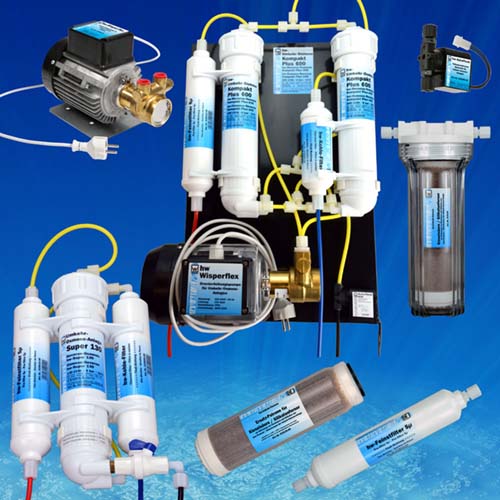Practical application of UV-C-radiation
Functional principle and advantages of an hw-UV-Watersterilizer
Aquarists know the problems:
Despite careful care, your fish swim “in the cloudy” or the long-awaited, successful breeding of your fish fails due to the fungal growth on the fish egg …
The reason for this is usually a contamination of the aquarium water by bacterial microorganisms, cloudy water or floating algae. Their spread is effectively, safely and without harmful side effects prevented by the use of hw® UV-Watersterilizer.
How a hw-UV-Watersterilizer works:
In a closed radiation chamber, the aquarium water is directed past an artificial, high-intensity UV-C radiation source. The bacterial microorganisms, cloudy water and floating algae in the water are so intensively irradiated with UV-C radiation that they are killed directly or are no longer capable of cell division and die.

The hw-UV-Watersterilizer
With the hw-UV-Watersterilizer, only the aquarium water flowing through the special glass jacket is exposed to the germicidal effect of UV-C light.
hw-UV-Watersterilizer are a special construction that has proven itself more than 100,000 times in research institutions, in the commercial sector and in ambitious hobby aquaristics.
Due to the extremely large contact surface to the direct UV-C radiation source in connection with a small layer thickness (3 to 4 mm) of the water to be irradiated, such an intensive irradiation is achieved as would otherwise only be achieved by devices with wattages almost twice as high ,
The special glass jacket used acts as a UV-C radiation reflector, which reflects the UV-C radiation back into the radiation room. In this way, the intensity of the radiation is significantly increased again and an increased power yield is realized. At the same time, the special glass jacket enables a precise function check of the UV-C burner as well as a status check of the radiation room.
The visible light penetrating outwards is completely filtered and completely harmless (corresponding to the light emission of a normal neon fluorescent tube …).
When UV-C radiation takes place, sterilized water from the hw®-UV-Watersterilizer constantly mixes with germ-rich water from the aquarium (nitrification bacteria in the filter and in the bottom of the aquarium are not damaged by UV-C radiation). So it is not a complete “disinfection” of the entire aquarium water, but a strong germ reduction (maximum germ reduction in the entire aquarium system approx. 98%) of the aquarium water.
This is extremely important and necessary, because the germs remaining in the water (approx. 2 to 3%) maintain the antibody production of the fish against pathogens and strengthen their immune system.
In the mini-ecosystem aquarium, due to the limited water volume without hw-UV-Watersterilizer, the bacterial load is many times higher than in nature and causes an extremely heavy load on the aquarium system. hw® UV water clarifiers restores the natural balance and create near-natural conditions in the aquarium.
Fresh water
Algae problems in fresh water
My water suddenly turned green, what has happened?
What happens there is commonly called “water bloom”. This type of algae problem means an almost explosive increase in the mass of single-cell floating algae. It usually arises when there is an excess of nutrients (nitrate-phosphate values) in the aquarium or when the temperature rises and there is increased solar radiation in summer. With this type of algae problem in fresh water, the mechanisms of action are diverse, but the end result is always the same: green aquarium water. This can be remedied very well with an hw-UV-Watersterilizer. In this device, the aquarium water is irradiated with UV-C-radiation, which causes the floating algae to die. At the same time, the strong germ pressure that always prevails in an aquarium is brought to a significantly lower level, so that the fish also benefit from a healthier environment.
I have algae problems on the aquarium glass. Small brown algae are everywhere, what is that?
This is proof that you have silicates in the tap or aquarium water.
These types of algae problems are so-called beard or brush algae (derived from their appearance). Only mechanical elimination helps here, but the problem would have to solve itself after a few days, because then the available quantities of silicates in the freshwater aquarium will be used up. If this is not the case, treatment of the tap water with a reverse osmosis and downstream silicate filter can help.
How can I prevent so many algae from growing in the aquarium?
Every aquarist knows algae problems: Try to “limit” the nutrient input into the aquarium.
For example, more aquatic plants and fewer fish. Also check whether you mean fish feeding too well. Feed only as much as “disappeared” within a few moments, what then drifts through the water was definitely too much and only pollutes the aquarium water.
Seawater
Algae problems in sea water
A lot of algae is growing in the new marine aqauarium, why?
Algae problems often arise because the biology in your newly set up aquarium has not yet settled in. If a seawater aquarist needs one in excess, it is patience.
If you have done everything correctly, your new aquarium should currently only contain sea water, substrate and a more or less large amount of so-called “living rock”. The filter should have been running for a few days and the protein skimmer will separate out considerable amounts. The lighting should still be OFF! In any case for the first 3-6 days, after that the lighting can always be switched on for a few hours.
There is such a red “slime” in the aquarium and overgrows everywhere, what is it?
These types of algae problems come from cyanobacteria, also incorrectly referred to as “red slim algae”.
The causes of the sudden occurrence of these pests in seawater are varied, but mostly have to do with sudden changes in environmental conditions. Various “miracle cures” are offered here to cope with this plague, but the successes (without side effects) are rather modest.
I use a UV-C-Unit and I still have algae problems. How can that be?
In a UV-C unit treats only the water flowing through is irradiated, which then mixes with the remaining aquarium water. So you can never completely “disinfect” the aquarium. In addition, you can “only” record with UV-C radiation what is carried through the device with the water flow. Algae, plants and bacteria on the decoration or in the substrate / filter of the aquarium are not affected by an hw-UV-Watersterilizer




